Designing With Area Rugs - July 2013
By Heidi Rodriguez of DKOR Interiors
You’ve selected the furniture, purchased the artwork, found the right drapes and chosen the accessories, but there is still a warmth and style missing from the newly designed space. The solution is probably simple, but it marks the beginning of another journey: choosing the right area rug.
If selected wisely, an area rug will offer a number of benefits beyond the aesthetic: defining a space, providing comfort, protecting the floor underneath and adding warmth—both visual and literal. DKOR Interiors believes that an area rug is the final touch that creates a finished look.
DKOR Interiors’ designers typically choose an area rug after having completed the space planning and having considered furniture, lighting and functionality. At this point, it is crucial to always keep the client’s needs in mind. Do they have children? Do they have pets? Where will the rug be used? Embarking on the journey of choosing the right area rug for a space can be challenging. It encompasses defining its function, style and materiality. It entails defining the type of lifestyle that the homeowner leads, where the rug will be located, how easily it is cleaned, which material to use and how long it will be in place. No matter what direction these inquiries lead, it is important to keep in mind that an area rug will play a crucial role within the grand design of a space.
With a wide variety of materials and styles to choose from, there is an area rug to accommodate every aesthetic and practical need. Following are some examples of how DKOR has chosen area rugs to address specific design issues.
ENLARGING A SPACE: This bedroom features an area rug whose linear yet organic pattern serves to visually enlarge the space, as well as to subtly bring in the exterior color palette. The area rug captures the green and blue hues of nature, as well as the creamy taupe of sand, while successfully pairing the soft-colored furniture and accessories.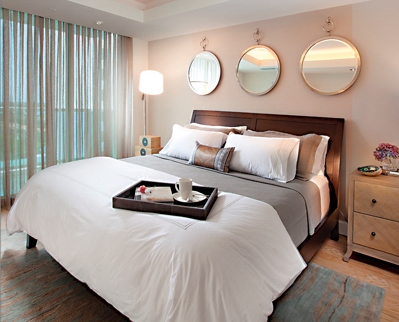
CREATING A SENSE OF WARMTH: In this space, the rectangular textured rug both reflects the warmth in color of the wood in the furniture pieces and shelters residents from the floor’s cold nature, creating cohesive harmony in this golden living room. The area rug also functions in assigning purpose to the space, defining it as a living area, a space for family gatherings and for welcoming guests. Finally, it elegantly adds a touch of intimacy to a space that was once long and empty.
One great advantage of area rugs is that they are so versatile. Replacing an area rug is an easy way of changing the entire feel of the space by simply choosing a brighter color and accessorizing accordingly. The choice of a water-hued rug here, to mimic the scenery outdoors, would change the feel of the space entirely.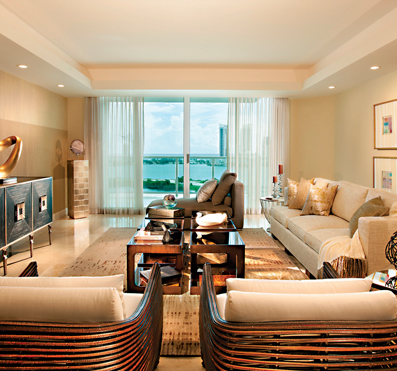
CREATING A TRANSITION: Long, rectangular area rugs easily create a transition between one space and another. This beautifully textured rug delineates a transition pathway between the entrance of the room and the balcony, capturing the colors of the ocean outside. The rich colors are also reflected in the mirrored cabinets, creating the feel of a larger space, and reinforced with the matching shams.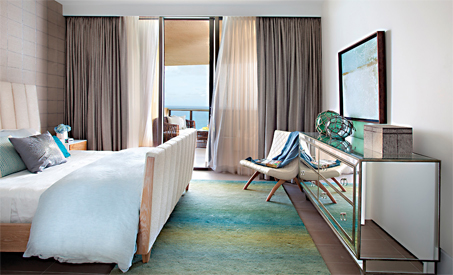
REINFORCING THE DÉCOR: Take a look at how this thick-woven, rustic rug accentuates the wood and softens a double-heighted space. The sisal/jute area rug effectively complements the light fixture and subtly contrasts the soft nature of the furniture that it frames. It perfectly blends the modern look of the space with the picturesque scene of the exterior.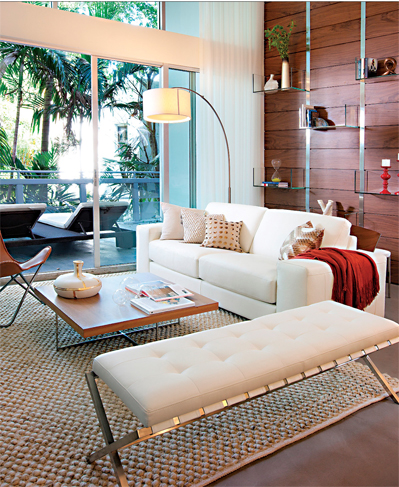
EVOKING LENGTH: Striped rugs can give the impression of a longer, larger area when placed opposite the furniture. This contemporary monochromatic area rug mirrors the soffit in the ceiling, directly framing the space above and adding visual interest to the space. The natural color scheme creates an interesting contrast with the lively art piece.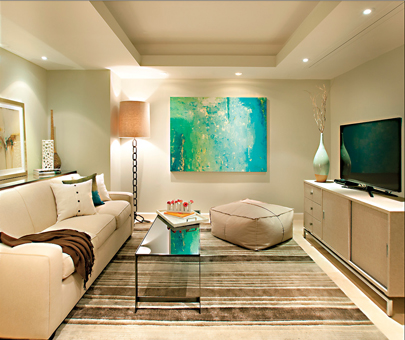
ADDING TEXTURE: This bedroom, which leads to an exterior dining area, is adorned with an area rug that both adds texture and complements the texture of the bedding set. It brings together the lighting fixture and the cream-colored lacquered furniture, as well as the art pieces and the dark floor tiles. The area rug adds the perfect touch of coziness to the room, while still retaining its modern, sleek look. 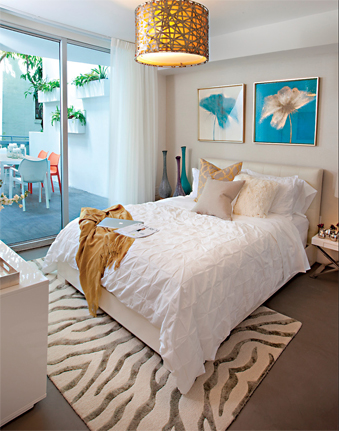
TYING TOGETHER A DESIGN: This beautiful damask-patterned area rug complements the lining of the drapes, creating a bright, colorful space in this eclectic dining room. The size of the area rug used defines the space as a dining area without confining it with an island look. The damask-patterned rug aids in uniting the classical aspects with the modern dining table and chairs, making this space a fun spot of color in the home. 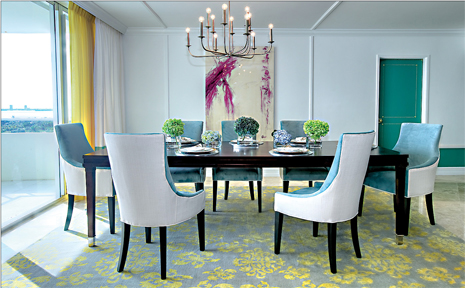
DENOTING SPACE: In much the same way that a walkway creates a path for pedestrians to follow, this area rug denotes the children’s play area. By connecting the two beds with this bright lime green rug, the perfect play space is created, almost confining the children to making their creative chaos only in this space—or so we hoped. The rug protects their feet when they hop out of bed, ensuring that they have somewhere to step before slipping on their shoes.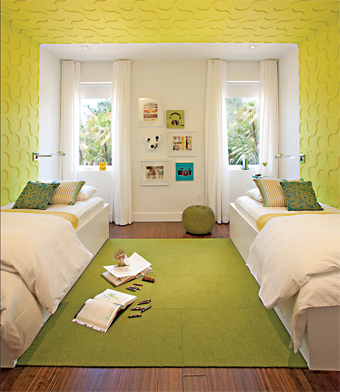
LAYING A FOUNDATION: Take a quick look. Where does your eye go? If your answer is the light pendants above, then we’ve achieved our purpose. The subtle style of the area rug chosen for this beachside penthouse keeps attention directed on the lighting pendant and also accentuates the traditional nature of the walls, pulling the design together into a cohesive whole. By uniting the contemporary and traditional elements of this design, the rug helps set the foundation of the transitional style.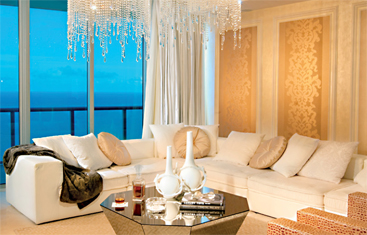
CREATING A FOCAL POINT: This gorgeous teal rug is the focal point of this room. A perfect combination with the light fixture, the ceiling’s wallpaper, and the teal accents on the drapes, this area rug is an invitation to gather around this cozy space. This is a great example of the dramatic impact that a rug can have on the design of a space. At the same time, area rugs are so versatile that by simply replacing it, one could achieve a whole new look without having to remodel the entire space. 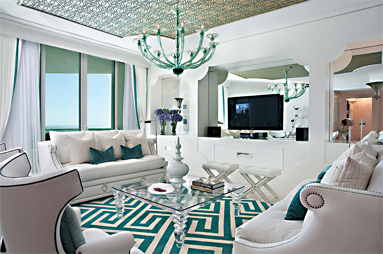
CATERING TO THE AUDIENCE: When selecting area rugs for children’s rooms, it is important to keep maintenance and cleaning in mind. Using a flatweave or low-pile rug reduces the look of wear and is more practical in terms of vacuuming and spot cleaning. In this room, the rug also acts as a cushion to protect children when they fall. This playfully patterned area rug immediately livens up this interactive playroom. 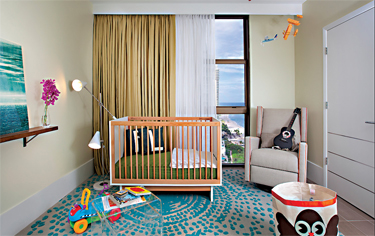
DIRECTING ATTENTION: Each area rug has a purpose, catered to the needs of the client. Although the blood red color of this area rug might deceive viewers into believing that it was intended to be the central focus of the room, take a look again and see where your eye instinctively goes.
This rich red area rug is a direct complement to the true central focus of the room: the painting. This space was designed to display sculptures, paintings and artwork, and every element used—including the area rug—is intended to achieve this purpose.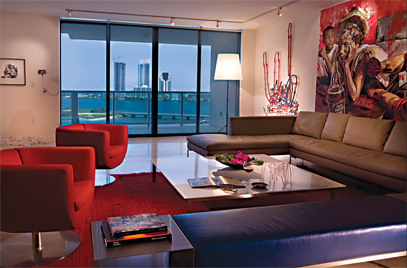

Copyright 2013 Floor Focus
